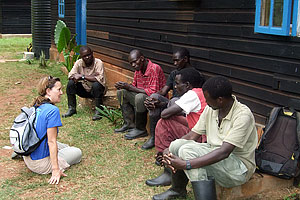 Amy Gotliffe talks to the Snare Removal Team at the Budongo
Amy Gotliffe talks to the Snare Removal Team at the Budongo
Snare Removal Project. The Oakland Zoo has supported them
since 1991.When you think of a zoo, what comes to mind? Animals in habitats? Children? Goat petting? Have you ever thought of zoos as supporters of wildlife conservation in the field?
It is time you did.
Zoos are actually one of the biggest supporters of field conservation for habitats and animals. In fact, as I write this on my laptop, I am looking around a giant conference room jammed with people from all over the world, representing zoological institutions, conservation organizations, NGOS, donor organizations and superstar field biologists. The bi-annual ZACC Conference (Zoos Committing to Conservation) is a way for zoos to connect with, partner with and support the wild cousins of their captive population. As we wait for the final speaker to present, the room is buzzing with inspired ideas and concrete plan-making.
Zoos and aquariums support conservation in a variety of ways, big and small. They raise and donate financial support, send medical, educational and operational supplies to projects, raise awareness through lectures, classes and publications, donate expertise by sending vets and other staff to project sites and sell indigenous wares in their gift shops. They band together with other zoos in their ecosystem to work on local conservation issues, breed and release species and provide medical attention to local wildlife. They also exercise their most valuable resource, education.
There are many admirable conservation organizations around the world, but zoos have a unique advantage: they welcome 175 million people through their gates each year. These families or individuals, on a nice, affordable day out, can be exposed to conservation messages at a variety of levels. In fact, zoos were ranked among the top most trusted messengers of wildlife conservation.
